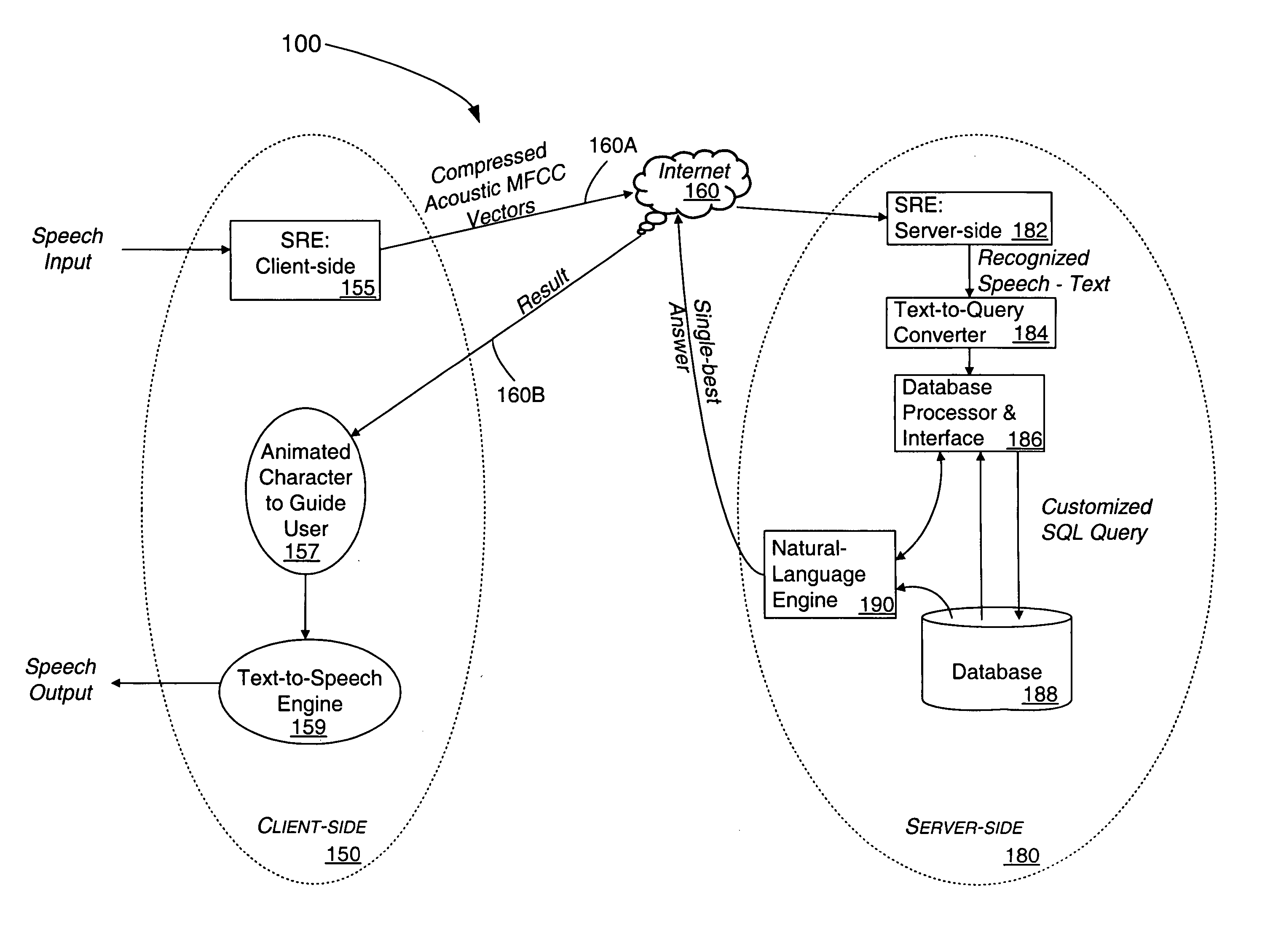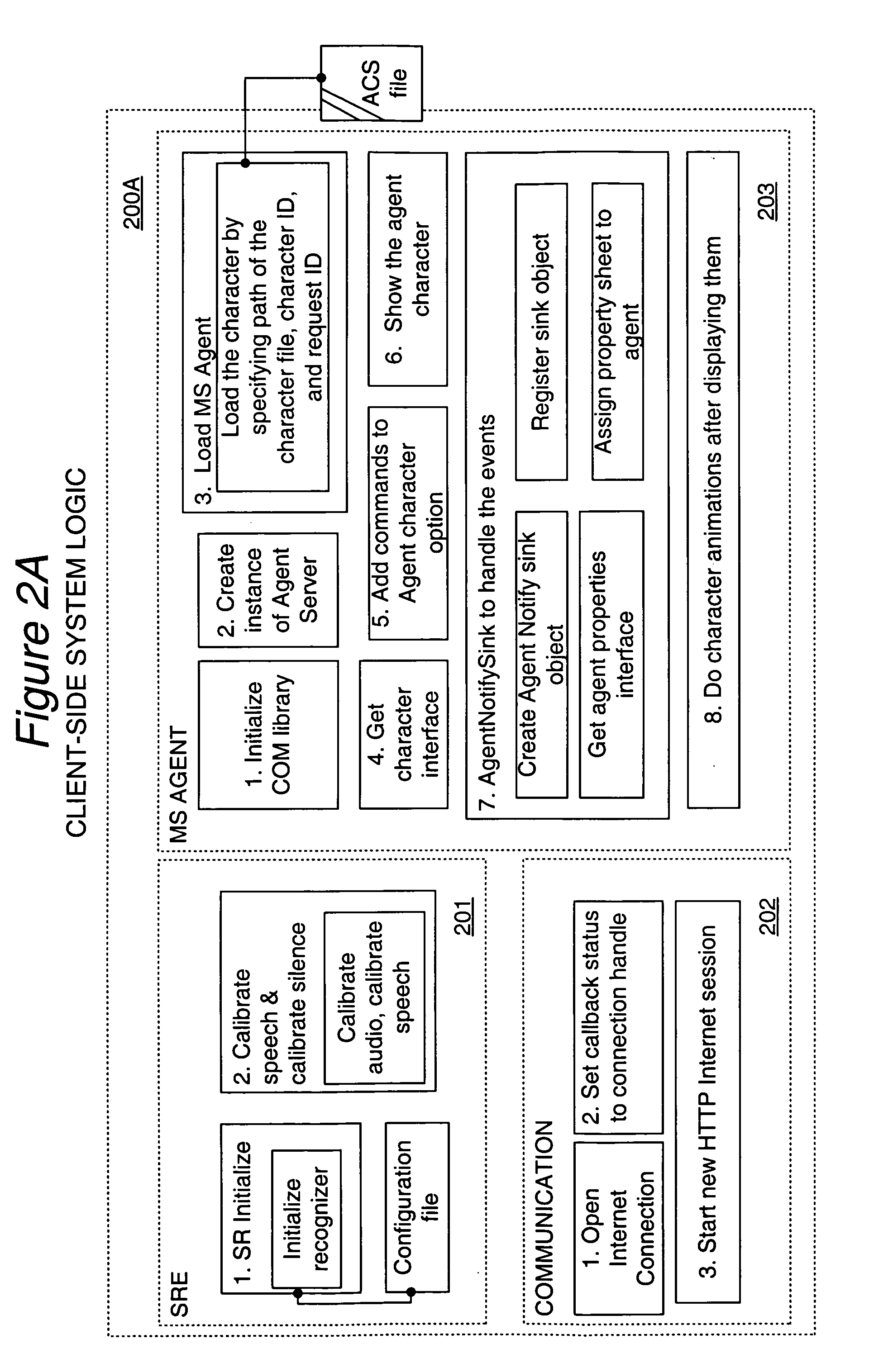Until now, however,
the INTERNET “experience” for users has been limited mostly to non-voice based input / output devices, such as keyboards, intelligent electronic pads, mice, trackballs, printers, monitors, etc.
This presents somewhat of a
bottleneck for interacting over the WWW for a variety of reasons.
First, there is the issue of familiarity.
In addition, many persons cannot or will not, because of physical or psychological barriers, use any of the aforementioned conventional I / O devices.
For example, many older persons cannot easily read the text presented on WWW pages, or understand the
layout / hierarchy of menus, or manipulate a mouse to make finely coordinated movements to indicate their selections.
Many others are intimidated by the look and complexity of computer systems, WWW pages, etc., and therefore do not attempt to use online services for this reason as well.
To date, however, there are very few systems, if any, which permit this type of interaction, and, if they do, it is very limited.
For example, various commercial programs sold by IBM (VIAVOICE™) and Kurzweil (DRAGON™) permit some
user control of the interface (opening, closing files) and searching (by using previously trained URLs) but they do not present a flexible solution that can be used by a number of users across multiple cultures and without
time consuming voice training.
Another issue presented by the lack of voice-based systems is efficiency.
While this is very advantageous (for the reasons mentioned above) it is also extremely costly and inefficient, because a real person must be employed to
handle such queries.
This presents a practical limit that results in long wait times for responses or high labor overheads.
In a similar context, while
remote learning has become an increasingly popular option for many students, it is practically impossible for an instructor to be able to field questions from more than one person at a time.
Even then, such interaction usually takes place for only a limited period of time because of other instructor time constraints.
To date, however, there is no practical way for students to continue a human-like question and answer type dialog after the learning session is over, or without the presence of the instructor to personally address such queries.
While a form of this functionality is used by some websites to communicate information to visitors, it is not performed in a real-time, interactive question-answer dialog fashion so its effectiveness and usefulness is limited.
While the HMM-based
speech recognition yields very good results, contemporary variations of this technique cannot guarantee a word accuracy requirement of 100% exactly and consistently, as will be required for WWW applications for all possible all user and environment conditions.
Thus, although
speech recognition technology has been available for several years, and has improved significantly, the technical requirements have placed severe restrictions on the specifications for the speech recognition accuracy that is required for an application that combines speech recognition and
natural language processing to work satisfactorily.
Because spontaneous speech contains many surface phenomena such as disfluencies,—hesitations, repairs and restarts, discourse markers such as ‘well’ and other elements which cannot be handled by the typical speech recognizer, it is the problem and the source of the large gap that separates speech recognition and
natural language processing technologies.
Except for
silence between utterances, another problem is the absence of any marked
punctuation available for segmenting the
speech input into meaningful units such as utterances.
However, most continuous speech recognition systems produce only a raw sequence of words.
Second, most of the very reliable voice recognition systems are speaker-dependent, requiring that the interface be “trained” with the user'
s voice, which takes a lot of time, and is thus very undesirable from the perspective of a WWW environment, where a user may interact only a few times with a particular website.
Furthermore, speaker-dependent systems usually require a large user dictionary (one for each
unique user) which reduces the speed of recognition.
This makes it much harder to implement a real-time dialog interface with satisfactory response capability (i.e., something that mirrors normal conversation—on the order of 3-5 seconds is probably ideal).
While most of these applications are adequate for
dictation and other transcribing applications, they are woefully inadequate for applications such as NLQS where the
word error rate must be close to 0%.
In addition these offerings require long training times and are typically are non
client-
server configurations.
Another significant problem faced in a distributed voice-based system is a lack of uniformity / control in the speech recognition process.
Thus, from the
server side perspective, it is not easy to assure uniform treatment of all users accessing a voice-enabled
web page, since such users may have significantly disparate
word recognition and error rate performances.
While a prior art reference to Gould et al.—U.S. Pat. No. 5,915,236—discusses generally the notion of tailoring a recognition process to a set of available computational resources, it does not address or attempt to solve the issue of how to optimize resources in a distributed environment such as a client-server model.
This reference therefore does not address the issue of how to ensure adequate performance for a very
thin client platform.
Moreover, it is difficult to determine, how, if at all, the system can perform real-time
word recognition, and there is no meaningful description of how to integrate the system with a natural
language processor.
Also, the streaming of the acoustic parameters does not appear to be implemented in real-time as it can only take place after
silence is detected.
 Login to View More
Login to View More  Login to View More
Login to View More 


